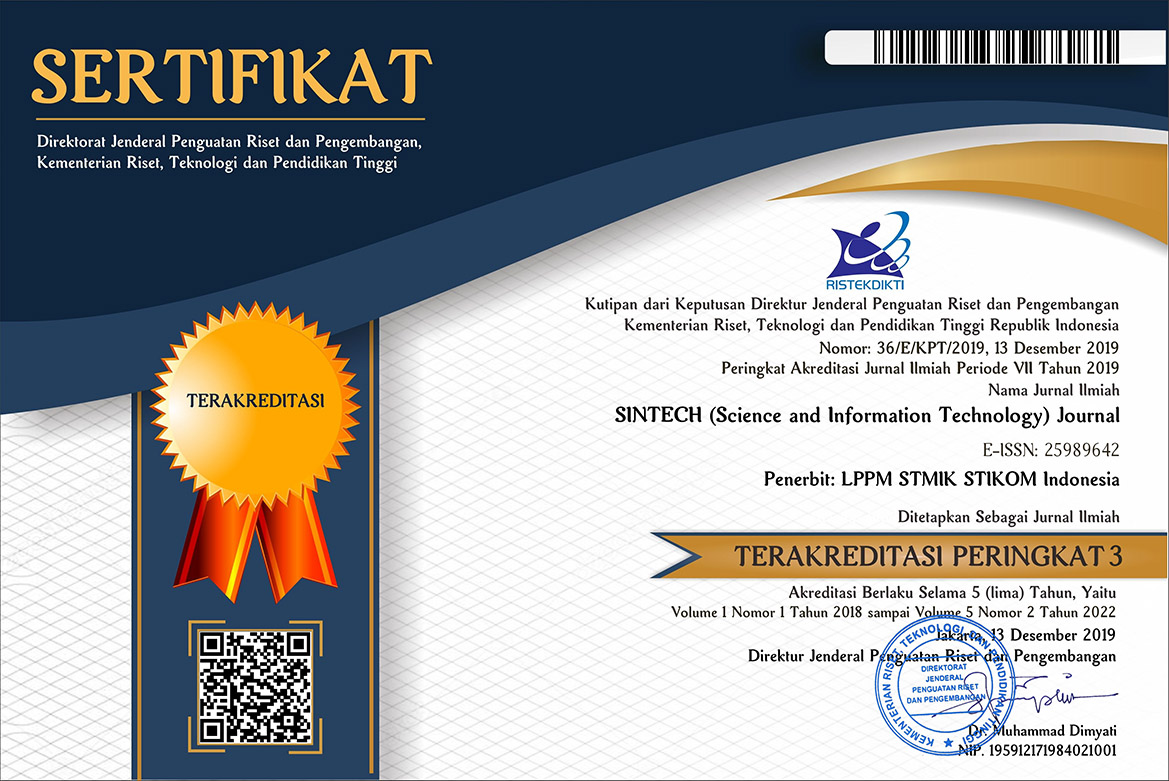Evaluasi Aplikasi Raileo Melalui Analisis Sentimen Ulasan Playstore Dengan Metode Naive Bayes
DOI:
https://doi.org/10.31598/sintechjournal.v7i1.1505Keywords:
ulasan, aplikasi, raileo, NB, sentimenAbstract
Abstrak
The Raileo application is a staffing platform owned by PT. KAI, functions as a personnel data management system. Effective application development requires data as a basis, and one source of data that can be utilized is user reviews. User reviews provide valuable information regarding application performance, user needs, and security aspects. However, challenges arise in managing review data which often contains sarcasm, creating ambiguous meaning and lowering accuracy levels. This research proposes a solution by applying sentiment analysis using Naive Bayes logarithms to 1047 Raileo review data. This method produces an accuracy rate of 94%, with positive and negative sentiment classification. The research results show the words that appear most frequently in Raileo reviews, such as "eror", "sulit", "titik presensi", "titik absen", "titik lokasi", "bug", "lemot," "gagal", "mantap", "bagus", "oke", "mudah", "mempermudah", "mantul", "lengkap","keren","ok", "inovatif", "inovasi", "semoga", "sukses", dan "membantu". These words can be used as a key to analyze all the sentiments contained in the review. In addition, this research identifies "presence point" as the highest negative sentiment word that needs attention in further development. From this sentiment analysis research, the Raileo application produces the highest sentiment value, namely positive sentiment
Downloads
References
J. E. Reyes Arias, K. Kurtzhall, D. Pham, M. W. Mkaouer, and Y. N. Elglaly, “Accessibility Feedback in Mobile Application Reviews: A Dataset of Reviews and Accessibility Guidelines,” in CHI Conference on Human Factors in Computing Systems Extended Abstracts, New York, NY, USA: ACM, Apr. 2022, pp. 1–7. doi: 10.1145/3491101.3519625.
A. Mohamed Mostafa, “Enhanced Sentiment Analysis Algorithms for Multi-Weight Polarity Selection on Twitter Dataset,” Intelligent Automation & Soft Computing, vol. 35, no. 1, pp. 1015–1034, 2023, doi: 10.32604/iasc.2023.028041.
J. Fiaidhi and S. Mohammed, “Thick Data: A New Qualitative Analytics for Identifying Customer Insights,” IT Prof, vol. 21, no. 3, pp. 4–13, May 2019, doi: 10.1109/MITP.2019.2910982.
S. Gupta and R. Sandhane, “Use of sentiment analysis in social media campaign design and analysis,” CARDIOMETRY, no. 22, pp. 351–363, May 2022, doi: 10.18137/cardiometry.2022.22.351363.
E. Jalali, Z. Zojaji, and M. Soleimani, “A Sentiment Analysis Dataset Preparation Framework: A Case Study on User Reviews Dataset on Iranian Tourist Destinations,” in 2023 9th International Conference on Web Research (ICWR), IEEE, May 2023, pp. 330–334. doi: 10.1109/ICWR57742.2023.10139217.
Abdul Rahman Fauzi, Ananda Hadi Saputra, and Muhammad Hasbi Abdillah, “Analisis Tingkat Kepuasan Pengguna Apex Mobile Berdasarkan Rating Dan Ulasan Google Play Store Menggunakan Naïve Bayes,” vol. 1, pp. 17–21, Aug. 2023.
S. A. R. Rizaldi, S. Alam, and I. Kurniawan, “Analisis Sentimen Pengguna Aplikasi JMO (Jamsostek Mobile) Pada Google Play Store Menggunakan Metode Naive Bayes,” STORAGE: Jurnal Ilmiah Teknik dan Ilmu Komputer, vol. 2, no. 3, pp. 109–117, Aug. 2023, doi: 10.55123/storage.v2i3.2334.
Java Khitamasari and Isa Faqihuddin Hanif, “Analisis Sentimen Ulasan User Terhadap Aplikasi Tix-Id Menggunakan Metode Naïve Bayes Pada Google Play Store,” Jurnal ICT : Information Communication & Technology, vol. 23, pp. 81–83, Jul. 2023.
Robiata Tsania Salsabila Aditya Putri, Dian Eka Ratnawati, and Dwija Wisnu Brata, “Perbandingan Naïve Bayes dan K-Nearest Neighbor untuk Analisis Sentimen Aplikasi Gapura UB Berdasarkan Ulasan Pengguna pada Playstore,” Jurnal Pengembangan Teknologi Informasi dan Ilmu Komputer, vol. 7, pp. 229–236, Jan. 2023.
Hery Oktafiandi, Winarnie, and Sayyid M. Raziq Olajuwon, “Perbandingan Algoritma untuk Analisis Sentimen Terhadap Google Play Store Menggunakan Machine Learning,” JURNAL EKONOMI DAN TEKNIK INFORMATIKA, vol. 11, pp. 16–21, Jul. 2023.
Sambodo Rio Sasongko, “FAKTOR-FAKTOR KEPUASAN PELANGGAN DAN LOYALITAS PELANGGAN (LITERATURE REVIEW MANAJEMEN PEMASARAN),” Jurnal Ilmu Manajemen Terapan, vol. 3, no. 1, pp. 104–114, Oct. 2021, doi: 10.31933/jimt.v3i1.707.
M. I. P. Hant and H. Hendry, “DATA MINING TECHNIQUE USING NAÏVE BAYES ALGORITHM TO PREDICT SHOPEE CONSUMER SATISFACTION AMONG MILLENNIAL GENERATION,” Jurnal Teknik Informatika (Jutif), vol. 3, no. 4, pp. 829–838, Aug. 2022, doi: 10.20884/1.jutif.2022.3.4.295.
A. Bhansali, A. Chandravadiya, B. Y. Panchal, M. H. Bohara, and A. Ganatra, “Language Identification Using Combination of Machine Learning Algorithms and Vectorization Techniques,” in 2022 2nd International Conference on Advance Computing and Innovative Technologies in Engineering (ICACITE), IEEE, Apr. 2022, pp. 1329–1334. doi: 10.1109/ICACITE53722.2022.9823628.
Mahardika Tania Nitami and Herny Februariyanti, “ANALISIS SENTIMEN ULASAN EKSPEDISI J&T EXPRESS MENGGUNAKAN ALGORITMA NAÏVE BAYES ,” Jurnal Manajemen Informatika & Sistem Informasi (MISI), vol. 5, pp. 20–29, Jan. 2022.
R. Wahyudi and G. Kusumawardana, “Analisis Sentimen pada Aplikasi Grab di Google Play Store Menggunakan Support Vector Machine,” Jurnal Informatika, vol. 8, no. 2, pp. 200–207, Sep. 2021, doi: 10.31294/ji.v8i2.9681.
Fauzan Setya Ananto and Firman Noor Hasan, “Implementasi Algoritma Naïve Bayes Terhadap Analisis Sentimen Ulasan Aplikasi MyPertamina pada Google Play Store,” Jurnal ICT : Information Communication & Technology , vol. 1, pp. 75–80, Jul. 2023.
R. Wati and S. Ernawati, “Analisis Sentimen Persepsi Publik Mengenai PPKM Pada Twitter Berbasis SVM Menggunakan Python,” Jurnal Teknik Informatika UNIKA Santo Thomas, pp. 240–247, Nov. 2021, doi: 10.54367/jtiust.v6i2.1465.
M. I. Petiwi, A. Triayudi, and I. D. Sholihati, “Analisis Sentimen Gofood Berdasarkan Twitter Menggunakan Metode Naïve Bayes dan Support Vector Machine,” JURNAL MEDIA INFORMATIKA BUDIDARMA, vol. 6, no. 1, p. 542, Jan. 2022, doi: 10.30865/mib.v6i1.3530.
S. M. Permataning Tyas, B. S. Rintyarna, and W. Suharso, “The Impact of Feature Extraction to Naïve Bayes Based Sentiment Analysis on Review Dataset of Indihome Services,” Digital Zone: Jurnal Teknologi Informasi dan Komunikasi, vol. 13, no. 1, pp. 1–10, Apr. 2022, doi: 10.31849/digitalzone.v13i1.9158.
F. Rahutomo and A. R. T. H. Ririd, “Evaluasi Daftar Stopword Bahasa Indonesia,” Jurnal Teknologi Informasi dan Ilmu Komputer, vol. 6, no. 1, pp. 41–48, Jan. 2019, doi: 10.25126/jtiik.2019611226.
F. Sidik, I. Suhada, A. H. Anwar, and F. N. Hasan, “Analisis Sentimen Terhadap Pembelajaran Daring Dengan Algoritma Naive Bayes Classifier,” Jurnal Linguistik Komputasional (JLK), vol. 5, no. 1, p. 34, Apr. 2022, doi: 10.26418/jlk.v5i1.79.
Abi Vegari and Setia Budi, “Implementasi Exploratory Data Analysis Pada Dataset Video Trending Harian YouTube,” Jurnal Strategi, vol. 2, pp. 397–411, Nov. 2020.
A. Halimi, K. Kusrini, and M. R. Arief, “ANALISIS SENTIMEN MASYARAKAT INDONESIA TERHADAP PEMBELAJARAN ONLINE DARI DI MEDIA SOSIAL TWITTER MENGGUNAKAN LEXICON DAN K-NEAREST NEIGHBOR,” COREAI: Jurnal Kecerdasan Buatan, Komputasi dan Teknologi Informasi, vol. 2, no. 1, pp. 18–28, Aug. 2021, doi: 10.33650/coreai.v2i1.2283.
. M., T. I. Fajri, and N. Hasdyna, “Classification of Graduation Students of the Faculty of Computers and Multimedia, Universitas Islam Kebangsaan Indonesia Using the Naïve Bayes Classifier Algorithm,” International Journal of Research and Review, vol. 9, no. 12, pp. 77–83, Dec. 2022, doi: 10.52403/ijrr.20221209.
B. Bakiyev, “Method for Determining the Similarity of Text Documents for the Kazakh language, Taking Into Account Synonyms: Extension to TF-IDF,” in 2022 International Conference on Smart Information Systems and Technologies (SIST), IEEE, Apr. 2022, pp. 1–6. doi: 10.1109/SIST54437.2022.9945747.
U. Bhimavarapu, G. Battineni, and N. Chintalapudi, “Automatic Classification of Hypertensive Retinopathy by Gray Wolf Optimization Algorithm and Naïve Bayes Classification,” Axioms, vol. 12, no. 7, p. 625, Jun. 2023, doi: 10.3390/axioms12070625.
K. Suzuki and T. Matsuzawa, “Model Soups for Various Training and Validation Data,” AI, vol. 3, no. 4, pp. 796–808, Sep. 2022, doi: 10.3390/ai3040048.
Downloads
Published
How to Cite
Issue
Section
License
Copyright (c) 2024 Haris Junianto, Primandani Arsi, Bagus Adhi Kusuma, Dhanar Intan Surya Saputra

This work is licensed under a Creative Commons Attribution-NonCommercial-ShareAlike 4.0 International License.
Copyright in each article belongs to the author.
- The authors admit that SINTECH Journal as a publisher who published the first time under
 Attribution-NonCommercial-ShareAlike 4.0 International (CC BY-NC-SA 4.0) License.
Attribution-NonCommercial-ShareAlike 4.0 International (CC BY-NC-SA 4.0) License. - Authors can include writing separately, regulate distribution of non-ekskulif of manuscripts that have been published in this journal into another version (eg sent to respository institution author, publication into a book, etc.), by recognizing that the manuscripts have been published for the first time in SINTECH Journal















1.png)




